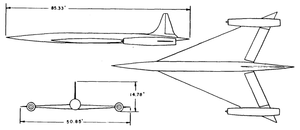- SSM-A-5 Boojum
-
XSSM-A-5 Boojum 
The final design of the XSSM-A-5Type Cruise missile Place of origin  United States
United StatesService history Used by United States Air Force Production history Designed 1946-1951 Manufacturer Northrop Corporation Number built 0 Specifications Weight 112,000 pounds (51,000 kg) Length 85 feet 4 inches (26.01 m) Height 14 feet 9 inches (4.50 m) Warhead Nuclear Engine Two J47 turbojets Wingspan 50 feet 10 inches (15.49 m) Operational
range3,153 mi (5,075 km) Flight ceiling 70,000 feet (21,000 m) Speed Mach 2 Guidance
systemCelestial navigation The XSSM-A-5 Boojum, also known by the project number MX-775B, was a supersonic cruise missile developed by the Northrop Corporation for the United States Air Force in the late 1940s. Intended to deliver a nuclear warhead over intercontinental range, it was determined to be too ambitious a project given technical difficulties with the SM-62 Snark which it was to follow on from, and was canceled in 1951.
Contents
Development
As part of a United States Army Air Forces effort to develop guided missiles for the delivery of nuclear weapons, the Northrop Corporation was awarded a development contract in March 1946 for the design of two long-range cruise missiles. Designated MX-775, the contract called for a subsonic missile, the MX-775A, later designated SSM-A-3 Snark; and a more advanced supersonic missile, MX-775B, which in 1947 was given the name SSM-A-5 Boojum,[1] Northrop naming the missiles after characters from the works of Lewis Carroll.[2]
Given the company designation of N-25B, the design of the Boojum took place over the next several years, and produced a number of different variations on the concept. The finalized design called for a long, slender missile, fitted with delta wings, and powered by a pair of General Electric turbojet engines, mounted in nacelles near the tips of the wing.[1][N 1]
The missile was intended to be launched utilizing a rocket sled; air-launch from a Convair B-36 heavy bomber was an alternative that was studied.[1] The missile would climb at subsonic speeds to its operating altitude, then conduct a supersonic dash to the target area, being guided using a celestial navigation system.[1] A "slipper" type drop tank would be jettisoned halfway through the flight.[3] The Boojum was intended to be capable of carrying a warhead weighting up to 5,000 pounds (2,300 kg) over a range between 1,500 to 5,000 miles (2,400 to 8,000 km).[4]
Cancellation
At the end of 1946, the contracts that had been awarded to Northrop were revised; the Snark was canceled, while the Boojum was to be fully developed as an operational system.[5] Northrop lobbied for the reinstatement of the Snark, however; this was successful in getting the program reauthorized during 1947, with the Boojum being deferred to a follow-on project.[5]
Despite the design having been finalized, the United States Air Force (which the USAAF had become in 1948) determined that the project was technologically unfeasible, given continuing development difficulties and technical problems encountered during the Snark's development. Accordingly, in 1951, the Boojum project was canceled, before any prototypes of the missile had been constructed.[1][4]
See also
- EKR (missile)
- SM-64 Navajo
- SSM-N-9 Regulus II
References
- Notes
- ^ A similar configuration would later be used by the Lockheed SR-71 Blackbird reconnaissance aircraft.
- Citations
- Bibliography
- Collins, Martin J. (2007). After Sputnik: 50 Years of the Space Age. New York: HarperCollins. ISBN 978-0-06-089781-9. http://books.google.com/books?id=rZ53HRR5lUQC&pg=PA26. Retrieved 2011-02-12.
- Parsch, Andreas (2007). "Northrop SSM-A-5 Boojum". Directory of U.S. Military Rockets and Missiles. designation-systems.net. http://www.designation-systems.net/dusrm/app1/ssm-a-5.html. Retrieved 2011-02-12.
- Polmar, Norman; Robert Stan Norris (2009). The U.S. Nuclear Arsenal: A History of Weapons and Delivery Systems Since 1945. Annapolis, MD: Naval Institute Press. ISBN 978-1557506818. http://books.google.com/books?ei=RuZFTaSsEsG88gaS-N21DQ&ct=result&id=rKkpAQAAIAAJ&dq=W41+warhead&q=W41#search_anchor. Retrieved 2011-02-12.
- Werrell, Kenneth. (1985) The Evolution of the Cruise Missile. Maxwell AFB, AL: Air University Press. ASIN B000R51FWA. Retrieved 2011-02-12
1947-1951 United States Air Force rocket and missile designationsAir-to-air missiles AAM-A-1 • AAM-A-2
Air-to-surface missiles ASM-A-1 • ASM-A-2
Surface-to-air missiles SAM-A-1
Surface-to-surface missiles Launch test vehicles LTV-A-1
Propulsion test vehicles Rocket test vehicles Types of missile By platform - Air-to-air missile (AAM)
- Air-to-surface missile (ASM)
- Surface-to-air missile (SAM)
- Surface-to-surface missile (SSM)
- Ballistic missile
- Intercontinental ballistic missile (ICBM)
- Submarine-launched ballistic missile (SLBM)
- Anti-ballistic missile (ABM)
- Intermediate-range ballistic missile (IRBM)
- Cruise missile
- Anti-ship missile (AShM)
- Anti-submarine missile
- Anti-tank missile (ATGM)
- Anti-satellite weapon (ASAT)
- Air-launched ballistic missile
- Anti-ship ballistic missile (ASBM)
By guidance Lists - List of missiles
- List of missiles by country
- List of military rockets
Categories:- Abandoned military rocket and missile projects of the United States
- Cold War missiles of the United States
- Nuclear cruise missiles of the United States Air Force
- Cold War cruise missiles
Wikimedia Foundation. 2010.
